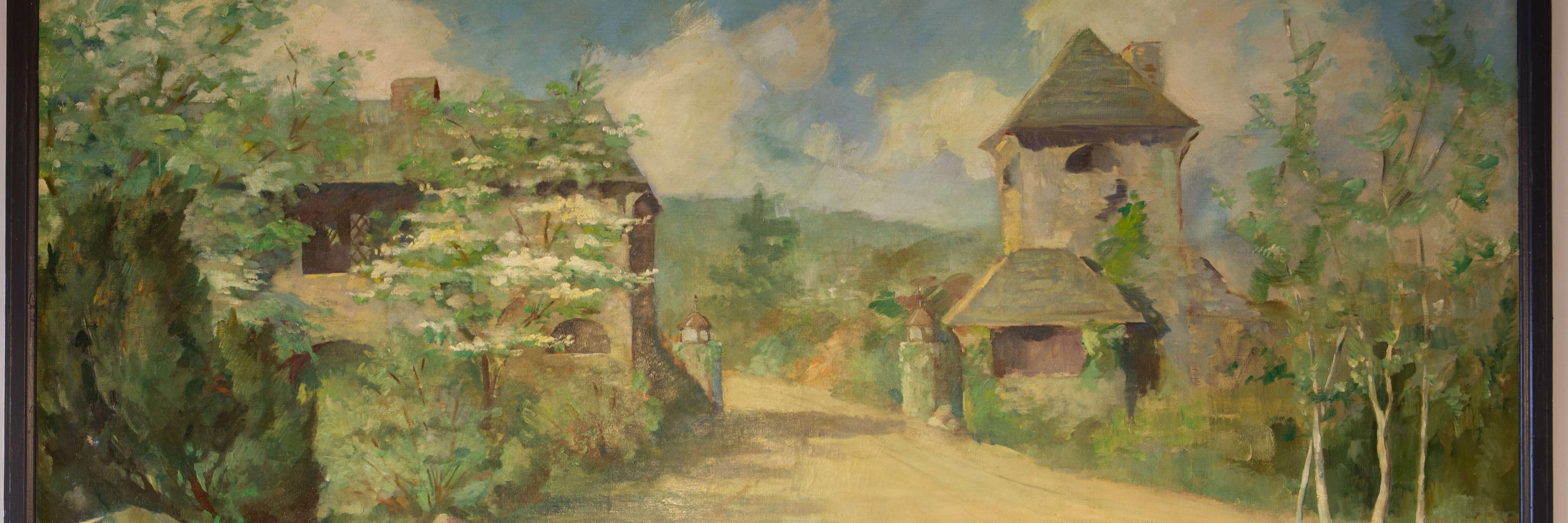Club History
In a drenching rain one afternoon in September 1885, two men stood on the rear platform of the New York, Lake Erie and Western Railroad's Buffalo Express as it chugged noisily through the quiet woods beside the Ramapo River. As the train rattled past the thirty-five milepost from Jersey City and began to grumble at the steeper grade, one of the two leaned far out and waved ahead to the conductor. "All right," he shouted, "signal to stop-now!" With a squeal of brakes, the train slowed down, and the two men jumped off. An instant later, the train had picked up speed and vanished between the hills.

The two men were tobacco heir Pierre Lorillard IV and his friend Bruce Price, a young architect. Turning up their collars, for they had neglected to bring raincoats, they clambered up the embankment above the tracks and trudged off through the mud. Before them rose a wild, heavily wooded hillside. Only a tiny brick schoolhouse and an orchard showed that mankind had ever been there. By the time the two men had reached an open wagon awaiting them on a dirt road, which straggled past this little building, they were soaked to the skin.
An hour later, after three miles of boulders and thickets through which the wagon barely squeezed, they reached the top of the winding ascent and halted on a ridge overlooking a lake. This would have been at the top of what is now Tower Hill Road. At the north end were some cleared fields and a hut. Pointing there, Mr. Lorillard said: "That is a good site for the clubhouse. Don't you think so? And we can have a row of cottages between there and here." And with that, Pierre Lorillard IV had envisioned Tuxedo practically as it stands today.
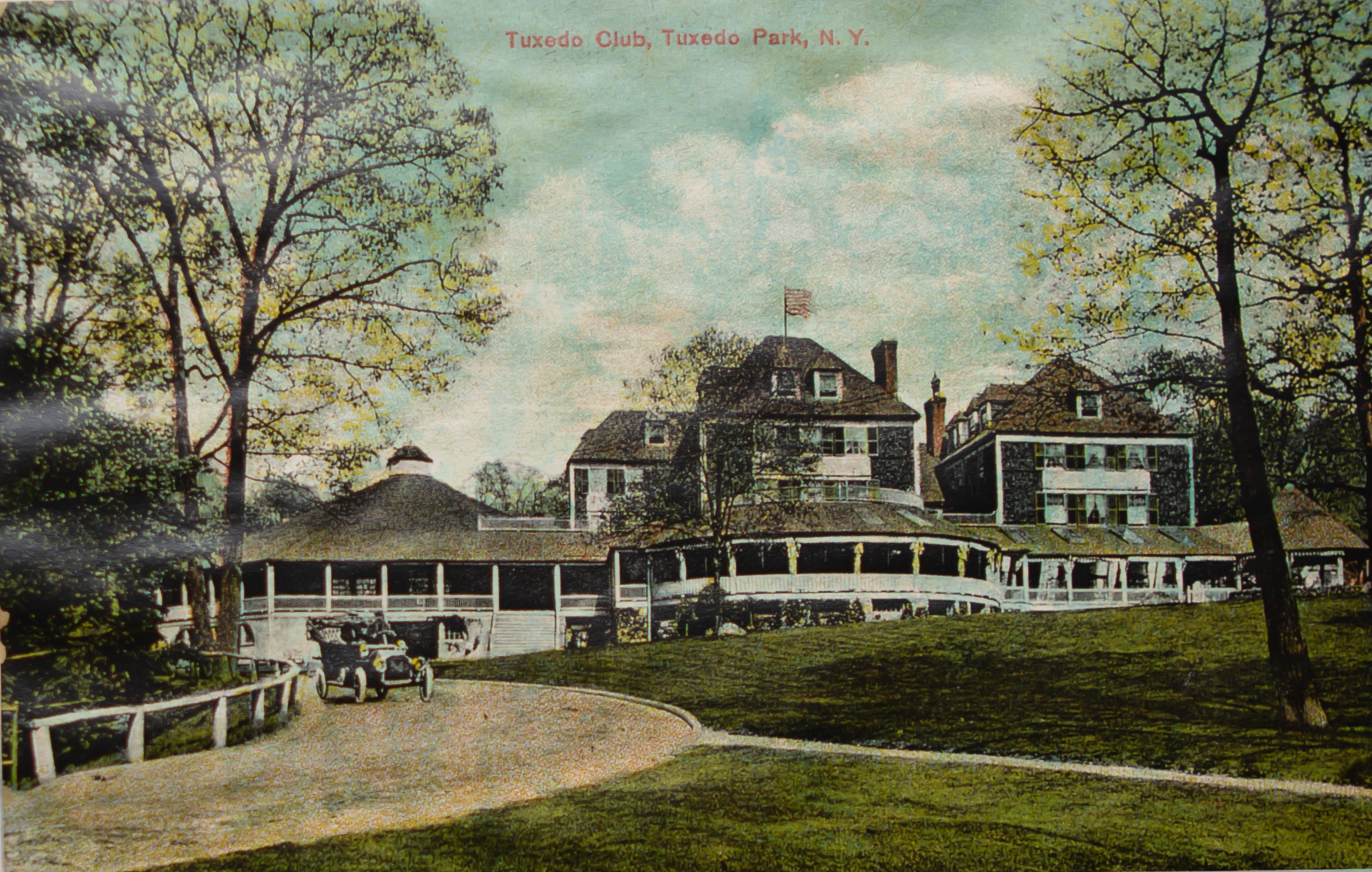
Bruce Price had an army of men on the spot.
1,800 men were imported and lodged in a small city of shanties built along regular streets with such names as "Fifth Avenue," "Broadway," and "Corso." The mess-hall was called "Delmonico's," which was the fashionable New York City restaurant at that time. Working with only the primitive tools then available, the men from this camp succeeded in building thirty miles of graded dirt and macadam roads, a water and sewage system (the first complete one in the world), the Park gatehouse and police station, twenty-two cottages, two blocks of stores, the village stables, a new dam, an icehouse, a swimming tank and a hatchery. The clubhouse itself was a huge gray wooden building with wide porches. It was designed in the comfortable living style of the day, with spacious public rooms and complete facilities for entertainment as well as sport. The ballroom, which was quite large and round in shape, instantly became one of America's most famous rooms.
By May 30, 1886, it was ready for the opening celebration.

Three special trains with 700 guests sped up from New York City. The run was supposed to take an hour and a half, but the exuberant engineers made it in forty minutes, to the alarm of the passengers, many of whom were frightened by the way the rickety old coaches careened on the narrow-gauge track. Despite their fears, they arrived safely at the Tuxedo station and were met by coaches and wagons painted brightly in the Club colors of yellow and green.
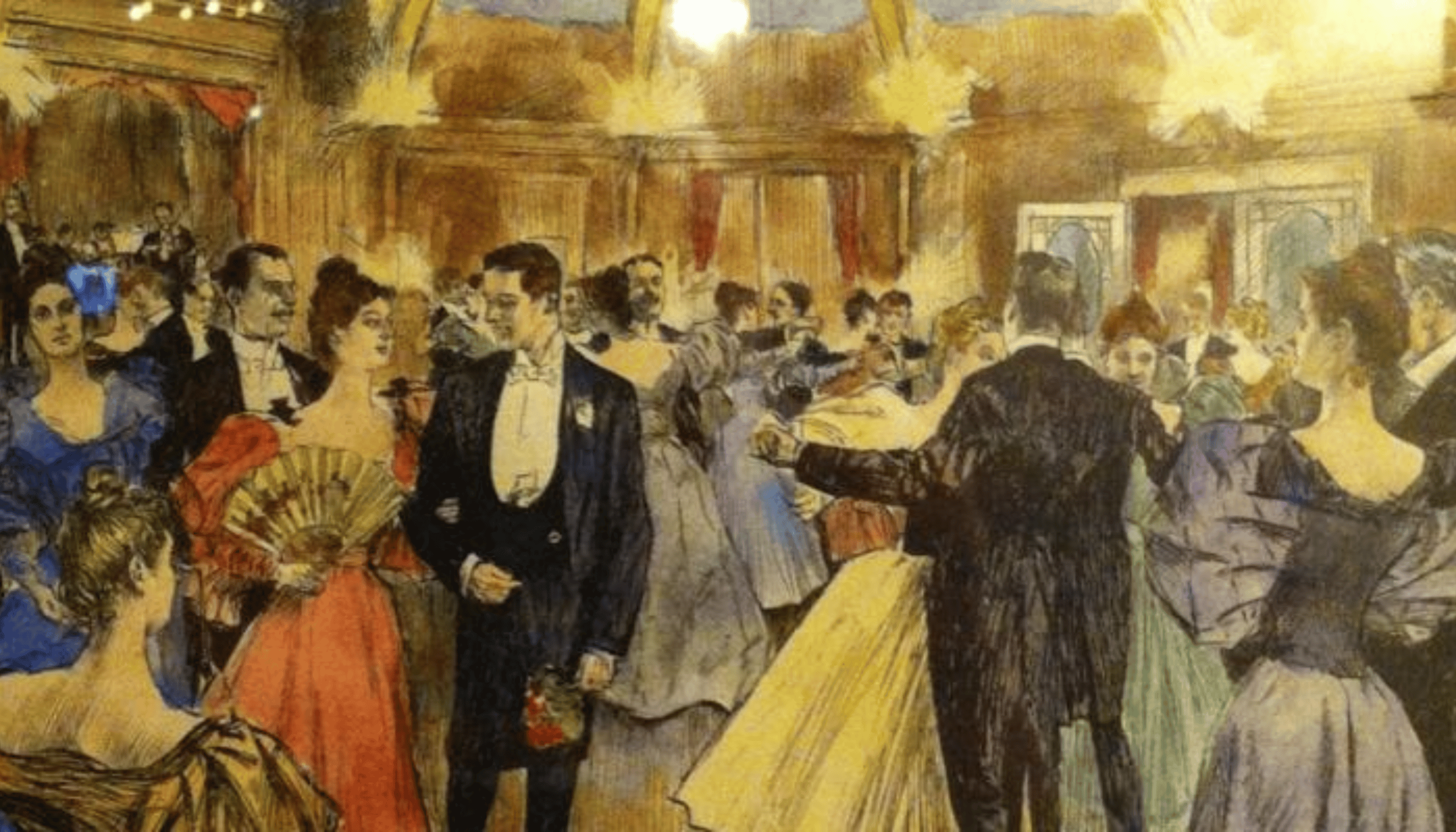
Under the stares of the country folk who had gathered from miles around, the party trotted merrily off on the trip to the Clubhouse. Beds of flowers lined the way, and every now and then gamekeepers adorned in green and yellow and wearing Tyrolese hats emerged self-consciously from the forest. Arriving at the Clubhouse, the visitors first went on a tour of exploration and then settled down to enjoy a garden party on the porches and the surrounding lawns. Some wandered away along the paths in search of deer, many went fishing, and a few boarded two special barges, each manned by crews in blue and white uniforms, for trips around the lake. In the evening, as the New York papers quaintly phrased it on the next day, "a hop was held."
A Google search of Tuxedo will reveal more than sixteen million references. The short-tailed dinner jacket as we know it today was first introduced to America by a member of The Tuxedo Club. There are differing reports of how this event occurred, but the account by Mr. Grenville Kane, founding member of The Tuxedo Club as told to J. Earle Stevens in 1929, appears to be the most authentic. In the summer of 1886, Tuxedo Club member James Brown Potter and his lovely wife, Cora, while on a visit to England, were invited by the Prince of Wales to join him at Sandringham, his country estate, for the weekend. Prior to going, Mr. Potter asked the Prince what he should wear for dinner. The Prince replied that he had adopted a short jacket in the place of a tailcoat for dinner in the country and that if Mr. Potter went to his tailor in London, he could get a similar jacket made. Mr. Potter did as the Prince suggested. When he returned to America, Mr. Potter's friends at The Tuxedo Club were not only impressed by the account of his visit to Sandringham but also found the jacket Mr. Potter brought back more appropriate than tails for informal dinners, and so they had it copied by their own tailors. It then became the custom for members of the Club to wear this attire to informal dinners in Tuxedo Park. One evening, a group of members wore their new dinner jackets to a bachelor dinner at Delmonico's. Their jackets attracted the attention of other diners who, upon enquiry were told "oh, that is what they wear for dinner up at Tuxedo." And so, from that day forth, the name Tuxedo was forever associated with this style of formal wear.

The first Autumn Ball was held shortly after the Club's opening in October, 1886, and was covered by all of the New York society pages. This would remain the case for the next 75 years, as generations of American girls thought of the Ball as the most important place to make their debuts. The tradition ended in the 1970s as an annual event, but several Autumn Balls have been held at the Club sporadically since.
A few bold spirits initiated golf at Tuxedo in 1889. A six-hole course was laid out on what are now the Tuxedo Park School grounds. Lorillard had to send to Montreal to obtain clubs with which to play, and on this newly opened golf course a driving competition was held, which was won by Dr. E.C. Rushmore. By 1892 the sport had become so popular that a nine-hole course was laid out near the old North Gate of the Park. The old caddie shack remains in ruins to this day. An eighteen-hole course was completed shortly thereafter, which straddled both sides of Route 17. (This 18-hole course was moved to its current location in the 1950s to accommodate the New York Thruway).

The country's first interclub team match was a four-way contest held at Tuxedo in 1894. The teams were The Country Club (Brookline, MA), St. Andrew's, Shinnecock and The Tuxedo Club. The trophy presented that year to The Country Club was donated to the U.S.G.A and is now the U.S.G.A.'s Senior Open trophy. Although the names of all the players at the first match cannot be ascertained, Tuxedo was represented by: E.C. Rushmore, Alfred Seton, Edward C. Kent, and Walker B. Smith.
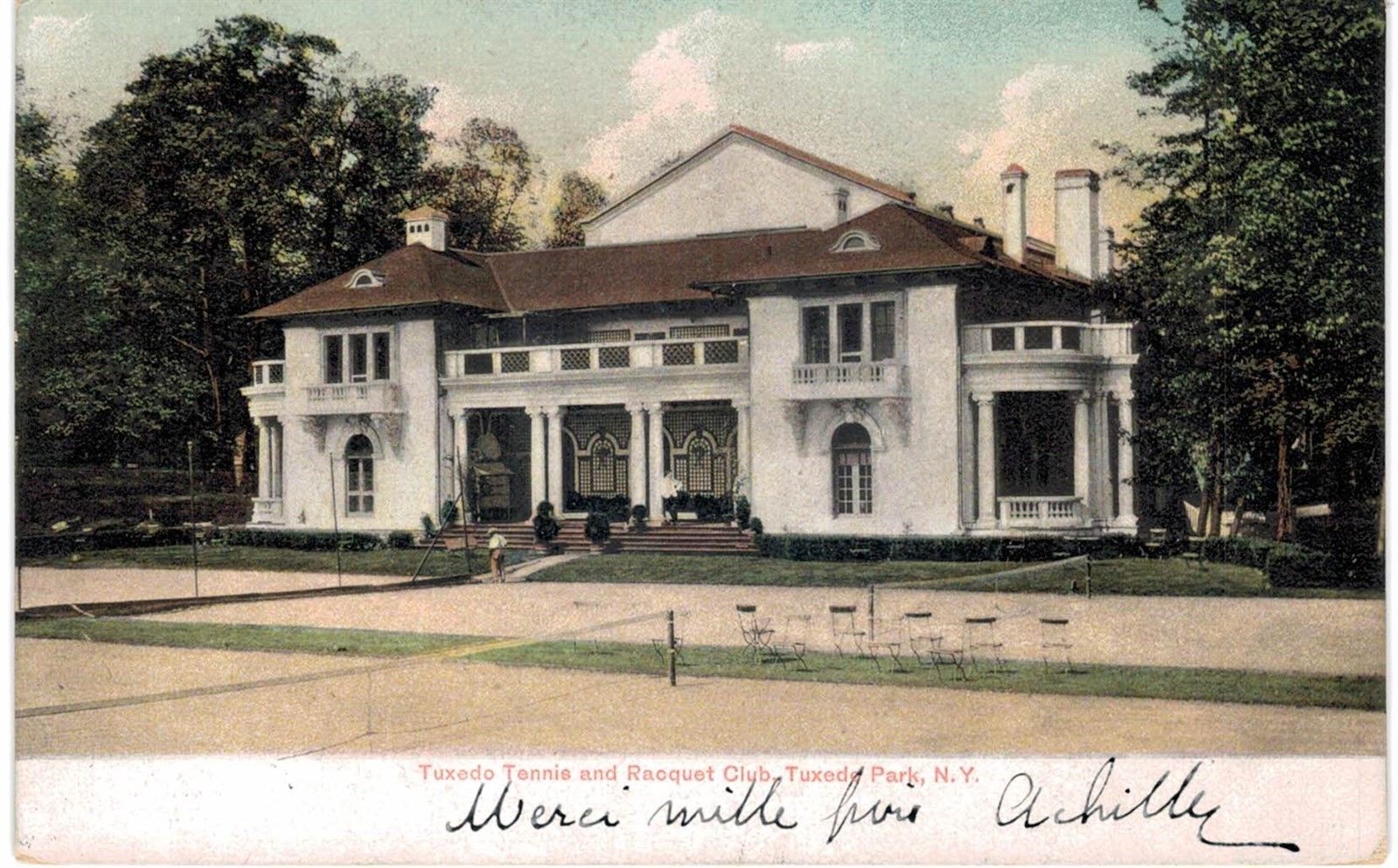
Many will argue that Tuxedo pioneered court tennis in the United States. Due chiefly to the energy of T. Suffern Tailer and his friend the Hon. Cecil Baring, a court was built and opened on December 30, 1899. The building was one of architectural firm Warren and Wetmore's first commissions. Mr. Lloyd Warren had been an early member of the Club. The first court tennis match played was between Messrs. Tailer and Baring, with Tailer the victor at 2-0. Shortly thereafter, Baring left the country with Mrs. Tailer, and they settled on an island in Ireland, building yet another court tennis court. Mrs. Tailer was a daughter of Pierre Lorillard. Later the same day, Eustace Miles, amateur champion of England, played Tom Pettit, the famous professional, who owed half 30 for a bisque. Miles won, 3-0, but lost a return match held a few weeks later.
On February 12, 1902, the rackets court was opened with a match between Clarence H. Mackay and Milton S. Barger, representing New York, against H.M. Brooks and George I. Scott, representing Philadelphia. New York won, 4-0. In April of the same year Charles E. Sands defeated O.S. Campbell to win the first Tennis Gold Racquet Championship. Two years later saw the first racquets competition for the Gold Racquet Championship, with Barger defeating Sands, who played under the name of "E. Edwards". In 1905, Sands won the Tennis Gold Racquet Championship by defeating Jay Gould, 3-1. Tuxedo is the only community in the world which can boast the combination of court tennis, lawn tennis, racquets, squash and platform tennis courts. Many young men and women who first learned to play the games here have become outstanding players.
During World War I, not only was there no Autumn Ball, but the Main Clubhouse was closed and demolished and the activities transferred to the Winter Clubhouse, which had been used in colder months as it was smaller and fitted with steam heat. Members quickly came to the conclusion that the Winter Clubhouse was too small for year-round use, and so in 1926 construction was started on the second Main Clubhouse, which was opened in the spring of 1928. Designed by John Russell Pope, its long lines were in striking contrast to the square wooden building it replaced. Built in the style of English country houses, it had open terraces instead of porches and a large new pool instead of the old swimming tank. When the new clubhouse was completed, the Winter Clubhouse was torn down, as Pope's building had been constructed for year-round use.
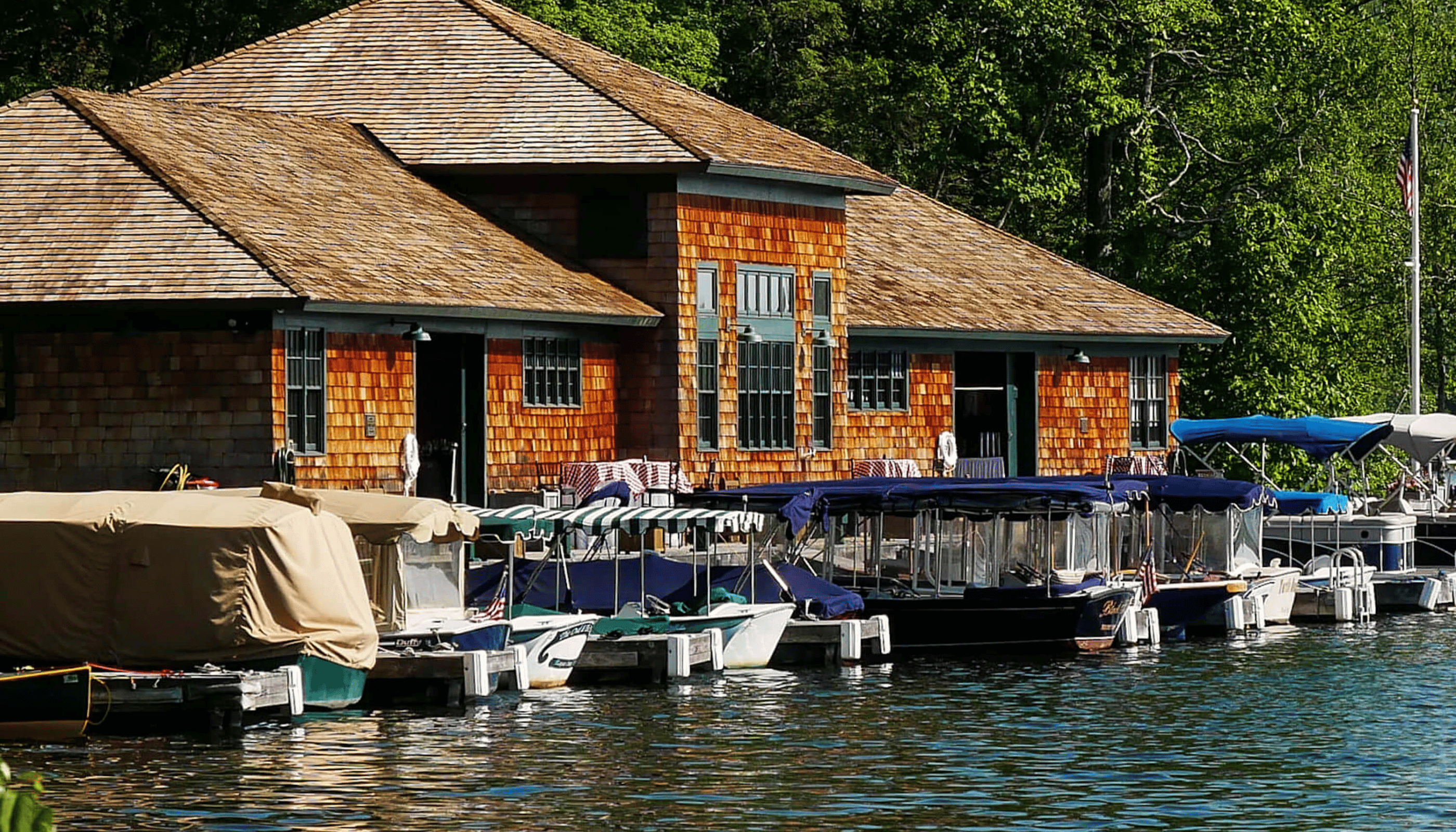
The new boathouse was built in 1938 and was named after Edwin C. Kent, a renowned authority on fishing and the particulars of the Tuxedo Lake. Kent had been elected to the first class of members in November, 1885.
A serious fire in 1943 partially destroyed the Main Clubhouse. Originating in an elevator shaft, the flames spread, according to the New York Herald Tribune, "with amazing rapidity…in a building that had been considered fireproof". It was equally amazing, perhaps, that the few people in the structure at the time escaped injury or worse. Indeed, many Club members braved the flames to rescue priceless furnishings and works of art, and many a Park house gave up space to store them for the day when the Clubhouse would be fully operative again. After the fire the Clubhouse was rebuilt, but to only one half of its original size.
The third rebuilding of the main club by architects Walker and Gillette, after the 1943 fire, proved to be satisfactory, despite the decrease in bedrooms and public areas (like Mr. Warren who built the Tennis House, Mr. Walker had been a Club member, and lived at the top of Tower Hill Road. His family included the Kanes, founders of Tuxedo Park). In 1955 the Member Dining Room was built, moving dining (and the kitchen) back upstairs where it had been before the fire of 1943. In 1967 the lounge (now Ballroom) was restored to its original dimensions, with the Billiards Room, which had been at its west end, moved back downstairs. Also in 1967, the Men's Bar was opened to all members and their guests. In 2006 the Club undertook and completed its most ambitious renovation to date of the Main Clubhouse. The Member Dining Room, kitchen, Stone Room, HVAC systems, employee living quarters and administrative staff areas were all entirely re-built.
The planning and building of the New York Thruway marked the end of the golf course at the north end of the Park. A new course had to be found. After extensive negotiations, wherein alternative sites were considered, a new and better golf course was built at the south end of town, approximately 2 miles from the end of the big lake, on the Morgan Hamilton Farm in Eagle Valley. On July 4, 1956, nine holes had been completed, a clubhouse built and play commenced. The following year the full 18 holes were in place. Robert Trent Jones, the golf course architect, took full advantage of Hamilton Farm to give Tuxedo its challenging and scenic course.

A new Golf Clubhouse, the Club's fourth in its 112 years, was constructed in 1998. Designed by architect Robert Lamb Hart, it includes luxurious changing rooms, a large bar, dining areas and covered porches.
Two platform tennis courts were constructed by the new golf house in 1999, replacing the original courts which had been located to the east of the Main Clubhouse and which had been demolished in the mid 1970's. Two additional platform tennis courts were added in January of 2006, followed by a "warming hut" completed in 2008.
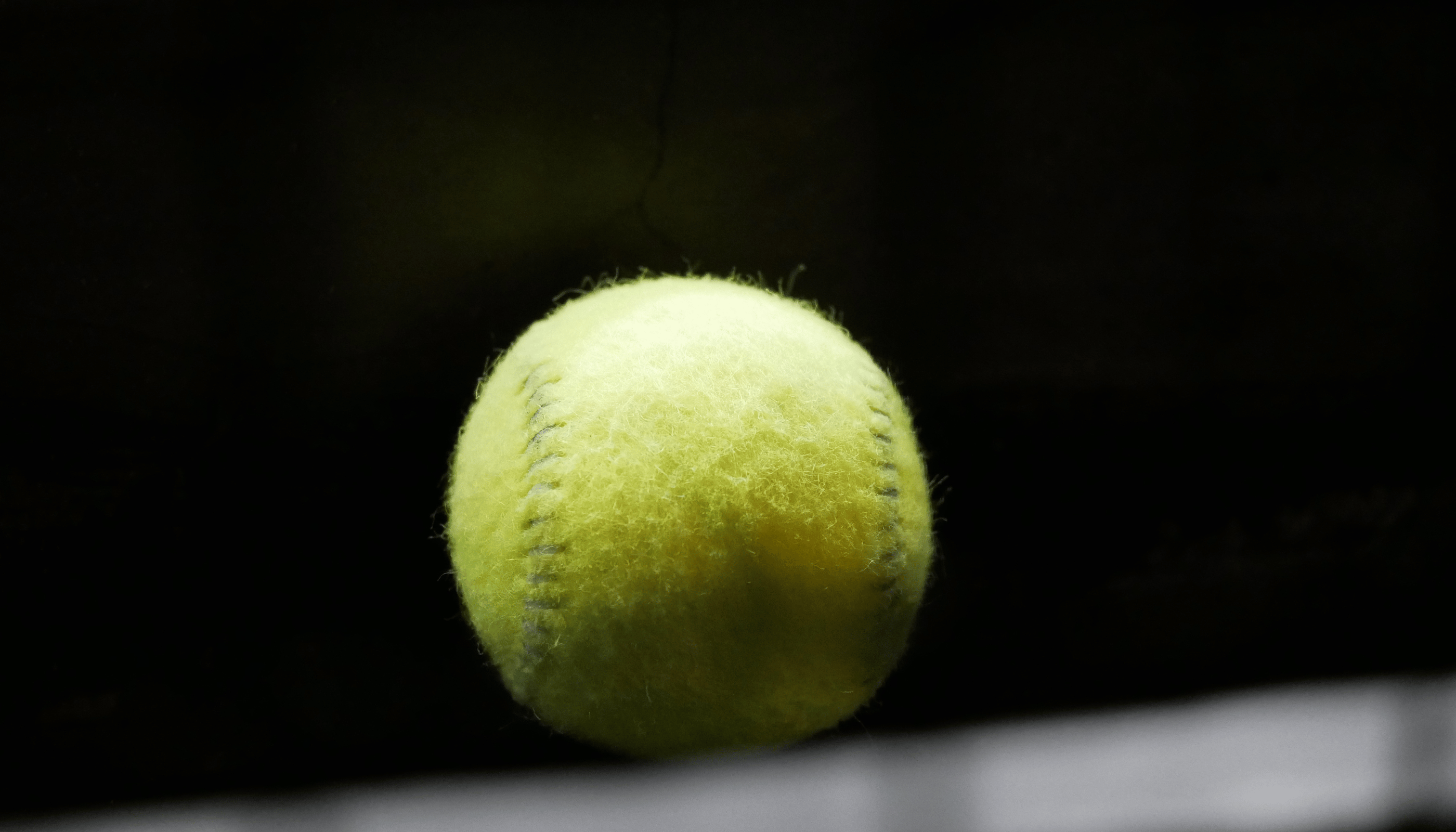
The Tennis House was renovated for the 2002 Centennial Gold Racquets. A new hallway was constructed which enabled women to go directly to their changing area from the courts without having to go outside or across the upstairs viewing areas. Air conditioning was added for the first time, and the original heating system in the Rackets Court was replaced.

The Tuxedo Club today is stronger in terms of its membership and its facilities than ever before. With the improvements of roads and other communications, membership has expanded to Bergen County and New York City. The increase in members has influenced the continued improvements of Club buildings and grounds and greater participation in Club life. The golf course, boathouse, swimming pool, padel courts (new!) platform tennis courts, lawn tennis courts, court tennis court, racquets court, squash courts, padel courts, Main Clubhouse, Tennis House and the Golf Clubhouse add up to the finest club facility in the world. No other place offers as many sports in such a beautiful setting. How fortunate are those who are a part of the wonderful Tuxedo Club.
